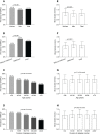Blood lactate levels are associated with an increased risk of metabolic dysfunction-associated fatty liver disease in type 2 diabetes: a real-world study
- PMID: 37223022
- PMCID: PMC10200915
- DOI: 10.3389/fendo.2023.1133991
Blood lactate levels are associated with an increased risk of metabolic dysfunction-associated fatty liver disease in type 2 diabetes: a real-world study
Abstract
Aim: To investigate the association between blood lactate levels and metabolic dysfunction-associated fatty liver disease (MAFLD) in type 2 diabetes mellitus (T2DM).
Methods: 4628 Chinese T2DM patients were divided into quartiles according to blood lactate levels in this real-world study. Abdominal ultrasonography was used to diagnosis MAFLD. The associations of blood lactate levels and quartiles with MAFLD were analyzed by logistic regression.
Results: There were a significantly increased trend in both MAFLD prevalence (28.9%, 36.5%, 43.5%, and 54.7%) and HOMA2-IR value (1.31(0.80-2.03), 1.44(0.87-2.20), 1.59(0.99-2.36), 1.82(1.15-2.59)) across the blood lactate quartiles in T2DM patients after adjustment for age, sex, diabetic duration, and metformin use (all p<0.001 for trend). After correcting for other confounding factors, not only increased blood lactate levels were obviously associated with MAFLD presence in the patients with (OR=1.378, 95%CI: 1.210-1.569, p<0.001) and without taking metformin (OR=1.181, 95%CI: 1.010-1.381, p=0.037), but also blood lactate quartiles were independently correlated to the increased risk of MAFLD in T2DM patients (p<0.001 for trend). Compared with the subjects in the lowest blood lactate quartiles, the risk of MAFLD increased to 1.436-, 1.473-, and 2.055-fold, respectively, in those from the second to the highest lactate quartiles.
Conclusions: The blood lactate levels in T2DM subjects were independently associated with an increased risk of MAFLD, which was not affected by metformin-taking and might closely related to insulin resistance. Blood lactate levels might be used as a practical indicator for assessing the risk of MAFLD in T2DM patients.
Keywords: HOMA2-IR; insulin resistance; lactate; metabolic dysfunction-associated fatty liver disease; type 2 diabetes mellitus.
Copyright © 2023 Ma, Ke, Wang, Wang, Xu and Li.
Conflict of interest statement
The authors declare that the research was conducted in the absence of any commercial or financial relationships that could be construed as a potential conflict of interest.
Figures




Similar articles
-
Serum iron is closely associated with metabolic dysfunction-associated fatty liver disease in type 2 diabetes: A real-world study.Front Endocrinol (Lausanne). 2022 Sep 5;13:942412. doi: 10.3389/fendo.2022.942412. eCollection 2022. Front Endocrinol (Lausanne). 2022. PMID: 36133303 Free PMC article.
-
GA/HbA1c ratio is a simple and practical indicator to evaluate the risk of metabolic dysfunction-associated fatty liver disease in type 2 diabetes: an observational study.Diabetol Metab Syndr. 2022 Nov 11;14(1):167. doi: 10.1186/s13098-022-00946-2. Diabetol Metab Syndr. 2022. PMID: 36369095 Free PMC article.
-
Decreased Serum Osteocalcin is an Independent Risk Factor for Metabolic Dysfunction-Associated Fatty Liver Disease in Type 2 Diabetes.Diabetes Metab Syndr Obes. 2022 Nov 29;15:3717-3728. doi: 10.2147/DMSO.S389794. eCollection 2022. Diabetes Metab Syndr Obes. 2022. PMID: 36471670 Free PMC article.
-
Clinical Classification of Obesity and Implications for Metabolic Dysfunction-Associated Fatty Liver Disease and Treatment.Diabetes Metab Syndr Obes. 2023 Oct 25;16:3303-3329. doi: 10.2147/DMSO.S431251. eCollection 2023. Diabetes Metab Syndr Obes. 2023. PMID: 37905232 Free PMC article. Review.
-
GATA3 as an immunomodulator in obesity-related metabolic dysfunction associated with fatty liver disease, insulin resistance, and type 2 diabetes.Chem Biol Interact. 2022 Oct 1;366:110141. doi: 10.1016/j.cbi.2022.110141. Epub 2022 Sep 2. Chem Biol Interact. 2022. PMID: 36058260 Review.
Cited by
-
Total cucurbitacins from Herpetospermum pedunculosum pericarp do better than Hu-lu-su-pian (HLSP) in its safety and hepatoprotective efficacy.Front Pharmacol. 2024 Feb 22;15:1344983. doi: 10.3389/fphar.2024.1344983. eCollection 2024. Front Pharmacol. 2024. PMID: 38455959 Free PMC article.
-
Ketone body metabolism and cardiometabolic implications for cognitive health.NPJ Metab Health Dis. 2024;2:29. doi: 10.1038/s44324-024-00029-y. Epub 2024 Oct 11. NPJ Metab Health Dis. 2024. PMID: 40093558 Free PMC article.
-
Machine learning identification of risk factors for heart failure in patients with diabetes mellitus with metabolic dysfunction associated steatotic liver disease (MASLD): the Silesia Diabetes-Heart Project.Cardiovasc Diabetol. 2023 Nov 20;22(1):318. doi: 10.1186/s12933-023-02014-z. Cardiovasc Diabetol. 2023. PMID: 37985994 Free PMC article.
-
Lactate Metabolism in Health and Disease.Adv Exp Med Biol. 2025;1478:573-613. doi: 10.1007/978-3-031-88361-3_24. Adv Exp Med Biol. 2025. PMID: 40879956 Review.
-
Comparison of the accuracy of predictive models in early detection of clinically relevant posthepatectomy liver failure.BMC Cancer. 2025 Aug 30;25(1):1400. doi: 10.1186/s12885-025-14738-0. BMC Cancer. 2025. PMID: 40885908 Free PMC article.
References
Publication types
MeSH terms
Substances
LinkOut - more resources
Full Text Sources
Medical

